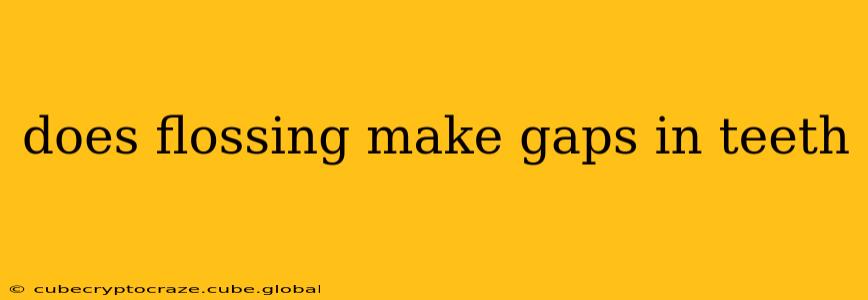Does Flossing Make Gaps in Teeth? Debunking the Myth
The question of whether flossing creates gaps between teeth is a common concern among many people. The short answer is no, flossing does not cause gaps in teeth. The idea that it does is a myth, likely stemming from a misunderstanding of gum health and the way flossing works. Let's explore this further and address some related anxieties.
What Causes Gaps Between Teeth (Diastema)?
Gaps between teeth, medically known as diastema, can have several causes:
- Genetics: This is often the primary reason. Some people are simply born with a wider space between their teeth.
- Tooth Size Discrepancy: If your teeth are smaller than the space available in your jaw, gaps can appear.
- Gum Recession: As gums recede, more of the tooth becomes visible, potentially creating the illusion of gaps. This is often a result of gum disease, not flossing.
- Tongue Thrusting: Habitual pushing of the tongue against the teeth can contribute to gaps.
- Oral Habits: Thumb-sucking or other oral habits, especially during childhood, can affect tooth alignment.
How Flossing Actually Affects Your Teeth and Gums
Flossing is crucial for removing plaque and food particles from between your teeth, areas your toothbrush can't reach. This prevents:
- Gum disease (gingivitis and periodontitis): These diseases can lead to gum recession, which might make existing gaps seem larger, but doesn't create new ones.
- Cavities: Removing food debris prevents the bacteria that cause cavities from thriving.
Proper flossing technique is gentle. It doesn't forcefully pry teeth apart. Any sensation of pressure should be minimal. If you're experiencing pain or discomfort while flossing, you might be using too much force or an unsuitable floss type. Consult your dentist for guidance on proper technique.
Does Flossing Make Teeth Loose?
Another related concern is whether flossing makes teeth loose. Again, the answer is no. Loose teeth are typically a sign of advanced gum disease or other underlying oral health issues, not a result of flossing. If your teeth feel loose, you should visit your dentist immediately.
What if I See a Gap After Starting to Floss?
If you notice a gap appearing after you begin flossing, it's unlikely the flossing is the cause. It's more probable that the gap was already present but was previously masked by swollen gums or food debris. Flossing helps to improve gum health, which might lead to gums shrinking slightly and revealing pre-existing gaps. This is not a negative side effect of flossing; rather, it's a sign of improved oral hygiene.
Is there a correct way to floss?
Yes, there is! Using the correct technique prevents damage to your gums. Your dentist or hygienist can show you the proper method, which typically involves using a gentle C-shape motion against each tooth to clean both sides of the interdental space.
In conclusion, the idea that flossing causes gaps in teeth is unfounded. Gaps are usually due to genetic factors or other underlying oral health conditions. Flossing, when done correctly, is essential for maintaining good oral hygiene and preventing more serious problems. If you have any concerns about your teeth or gums, consult your dentist for professional advice. They can provide personalized guidance and address any specific questions you may have.
